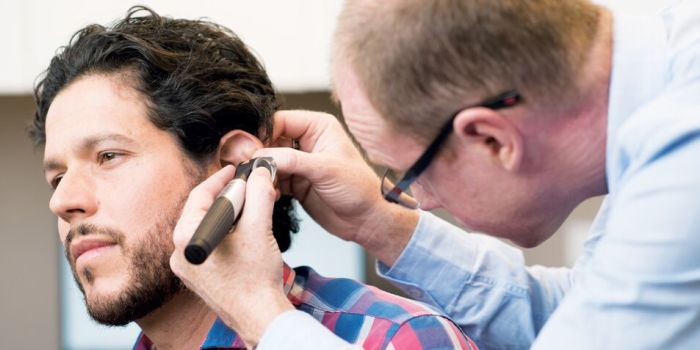Earwax removal – your common questions answered
Having some earwax in your ears is completely normal. You don’t usually need to have it removed. But if a build-up of earwax is starting to cause symptoms like hearing loss or earache, there are things you can do. Here I answer some common questions about earwax removal.

What is earwax?
Earwax is a substance produced in your ear canal. It’s made of skin cells and fluids that your glands release in your ear. It helps to keep your ear canal clean, and protects it from dirt, dust, hair, and water. It also helps to protect your ears from the growth of bacteria.
Why does earwax build up in your ears?
Your ear normally gets rid of earwax by itself. But sometimes, earwax builds up in your ear and starts to cause problems. This is called ‘impacted earwax’. There are some things that can make this more likely to happen, listed below.
- Being under 5 years of age. Impacted earwax is more common in young children when their ears are still developing.
- Being older than 50. Earwax becomes drier as you get older, and the hairs in your ear also become rougher. This makes it harder for your ears to get rid of the wax.
- Being male. Men tend to have more hair in their ears, which makes it harder for earwax to clear.
- Your ear canal shape. Having narrow or irregular-shaped ear canals can mean earwax gets blocked more easily.
- Having a skin condition like eczema or psoriasis.
- Using cotton buds inside your ears as this can push wax further in.
There’s often no particular reason for having a build-up of earwax. Your body might just produce a lot of earwax, or you might be more prone to having impacted earwax.
When should earwax be removed?
You only need to have earwax removed from your ear if it’s causing symptoms, or if your ear needs to be examined. Symptoms of impacted earwax can include:
- hearing loss (this is the most common symptom)
- your ear feeling blocked, full, or uncomfortable
- earache
- tinnitus (hearing a ringing, roaring, hissing, or buzzing sound in your ear)
- vertigo (feeling dizzy and sick)
How can I remove earwax at home?
You can try using olive or almond oil ear drops to soften earwax and help it to come out on its own. Do not use almond oil if you’re allergic to almonds.
You can also try sodium bicarbonate ear drops, but some people find this dries out their ear canal. Follow these steps to apply ear drops.
- Lie down and turn your head so the affected ear points upwards.
- Put the drops into your ear (if you can, ask someone else to do this for you).
- Wait for around five minutes before sitting up.
Always read the patient information leaflets that comes with the ear drops. You can usually use the drops three to four times a day, for up to five days.
Never try to remove earwax yourself using cotton buds or other objects. This can push the wax deeper into your ear and damage your ear canal or eardrum.
Don’t use ear candles to try and remove earwax. These are long tubes of fabric (cloth) soaked in beeswax that you place in your ear. Lighting the other end of the fabric candle is meant to draw any wax out of your ear. But there’s no evidence that ear candles work. They can be very dangerous and cause serious injury.
How does professional earwax removal work?
If ear drops don’t help and you’re still getting symptoms, speak with your GP. Sometimes, they may be able to offer treatments for earwax removal. Or they may refer you to a specialist ear care service for treatment.
Methods of earwax removal include:
- ear irrigation, where the wax is flushed out with water using an electronic device
- using a vacuum device to suck the wax out, known as microsuction, under a microscope
- manual removal where the wax is removed using a probe
Having a build-up of earwax can cause unpleasant symptoms. Contact your GP to find out about the most appropriate method of wax removal for you.
-
Sources Sources
- Cerumen impaction. Summary. BMJ Best Practice. Last updated 24 March 2023
- Earwax. Definition. NICE Clinical Knowledge Summaries. Cks.nice.org. Last revised March 2021
- Earwax. Risk factors. NICE Clinical Knowledge Summaries. Cks.nice.org. Last revised March 2021
- Earwax. Scenario: management. NICE Clinical Knowledge Summaries. Cks.nice.org.uk. Last revised March 2021
- Cerumen impaction. Diagnosis. History and exam. BMJ Best Practice. Bestpractice.bmj.com. Last reviewed 14 January 2022
- Earwax. Diagnosis. NICE Clinical Knowledge Summaries. Cks.nice.org.uk. Last revised March 2021
- Tinnitus: what is it? NICE Clinical Knowledge Summaries. NICE Clinical Knowledge Summaries. Cks.nice.org.uk. Last revised April 2022
- Ear. Removal of ear wax. NICE British National Formulary. Bnf.nice.org. Last updated 3 February 2022
- Cerumen impaction. Management - approach. BMJ Best Practice. Last updated 24 March 2023
- Ear candles. Tinnitus UK. Tinnitus.org.uk. Last updated April 2023
- Earwax: what are the complications? NICE Clinical Knowledge Summaries. Cks.nice.org.uk. Last updated March 2024
About our health information
At Bupa we produce a wealth of free health information for you and your family. This is because we believe that trustworthy information is essential in helping you make better decisions about your health and wellbeing.
Our information has been awarded the PIF TICK for trustworthy health information. It also follows the principles of the The Information Standard.

More general health advice articles
Did you find our advice helpful?
We’d love to hear what you think. Our short survey takes just a few minutes to complete and helps us to keep improving our healthy lifestyle articles.
Legal disclaimer
This information was published by Bupa's Health Content Team and is based on reputable sources of medical evidence. It has been reviewed by appropriate medical or clinical professionals and deemed accurate on the date of review. Photos are only for illustrative purposes and do not reflect every presentation of a condition.
Any information about a treatment or procedure is generic, and does not necessarily describe that treatment or procedure as delivered by Bupa or its associated providers.
The information contained on this page and in any third party websites referred to on this page is not intended nor implied to be a substitute for professional medical advice nor is it intended to be for medical diagnosis or treatment. Third party websites are not owned or controlled by Bupa and any individual may be able to access and post messages on them. Bupa is not responsible for the content or availability of these third party websites. We do not accept advertising on this page.







